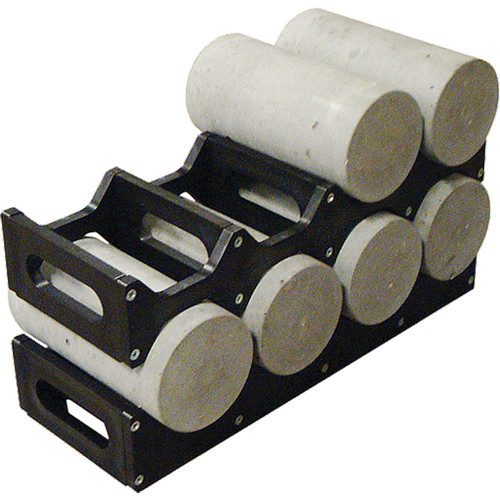Fast
Shipping
Quick,
Simple Ordering
Clear,
Upfront Pricing
Over 30,000
Happy Customers
Exceptional
Customer Service
Industry's Largest
Catalog
Curing Rack for 4x8in Traditional Concrete Cylinders, 12 Racks
Plastic cylinder curing racks are durable and provide open air flow for storing cylinders during curing. Made from recycled plastic to resist moisture, abrasion, chemicals and temperature changes. Each rack has handles for easy carry. Each rack holds (4) 4” x 8” cylinders and racks interlock to stack 12 high (58”).
RAAC construction especially in educational institutions has raised concerns lately with recent failures of RAAC structures so checks need to be done by the authorities soon.
RAAC panels constructed used in buildings constructed in the past have shown significant differences and safety risks compared to traditional reinforced concrete. Earlier reports of structural issues and safety warnings dating back to 80s and 90s need to continue and research on the material’s durability and safety in aging structures.
RAAC planks in schools and other public buildings constructed in the mid 20th century pose safety risks. Inspections and maintenance are crucial, government and engineering bodies are recommending its management and removal due to safety threats.
Reinforced autoclave aerated concrete (RAAC) is different from traditional reinforced concrete. RAAC is lighter and cheaper but much weaker and prone to structural failure especially when exposed to moisture while traditional reinforced concrete is more durable and has longer lifespan.
Structural safety is a big concern with RAAC as its risks and vulnerabilities can lead to big safety issues especially when the material ages or is exposed to moisture and can lead to structural failure.
Product Description
Reinforced Autoclaved Aerated Concrete (RAAC) is a type of lightweight, precast, cellular concrete building material used in construction since 1950s. It is made from a mixture of cement, lime, water and aeration agent poured into molds and then subjected to high pressure and heat, called autoclaving. RAAC is a porous material that is strong and light, good for building construction. But its limited durability and prone to structural failure raised concerns on safety risk especially in school buildings and other public structures where health and safety executive is top priority.
Technical Details
RAAC is an autoclaved aerated concrete with reinforcement usually in the form of steel rebar. Its technical specifications are:
-
Density: 400-600 kg/m³
-
Compressive strength: 2-5 MPa
-
Tensile strength: 0.5-1.5 MPa
-
Thermal conductivity: 0.1-0.3 W/mK
-
Fire resistance: up to 4 hours
-
Moisture resistance: moderate to high
RAAC comes in various forms, blocks, wall panels, floor and roof panels, cladding panels and lintels. It’s versatile and can be used for structural and non-structural applications.
Benefits for Engineers
RAAC has the following benefits for engineers:
-
Lightweight: RAAC is lighter than traditional reinforced concrete, easy to handle and transport.
-
High strength-to-weight ratio: RAAC has high strength-to-weight ratio, good for building construction.
-
Thermal insulation: RAAC has good thermal insulation, no need for additional insulation materials.
-
Fire resistance: RAAC has fire resistance, safe for building construction.
-
Sustainability: RAAC is made from natural materials, low carbon footprint, sustainable for building construction.
These benefits makes RAAC a good material for structural engineers to optimize building performance and sustainability.
Construction Applications
RAAC has many applications in construction:
-
Exterior and interior walls
-
Firewalls
-
Wet room walls
-
Diffusion-open thermal insulation boards
-
Intermediate floors
-
Upper floors
-
Stairs
-
Opening crossings
-
Beams
-
Pillars
RAAC is load bearing and can be used in various types of buildings, residential, commercial and industrial. Its versatility and performance makes it a popular choice for many construction projects.
Features and Benefits
RAAC has the following features and benefits:
-
Lightweight and easy to handle
-
High strength-to-weight ratio
-
Good thermal insulation
-
Fire resistance
-
Sustainability
-
Can be routed, sanded or cut to size on-site using standard power tools
-
Can be finished with various materials, polymer-modified stucco or plaster compound, natural or manufactured stone, veneer brick, metal siding and vinyl siding.
However RAAC also has its limitations and drawbacks, limited durability and prone to structural failure especially when exposed to moisture. So it’s important to follow proper installation, maintenance and inspection to ensure safety and integrity of RAAC structures.
RAAC Curing Box Accessories:
Concrete Transport Cylinder Racks store and transport multiple specimens
Curing Tank Circulator enhances tank circulation
Curing Tank Heater maintains constant temperature for concrete



